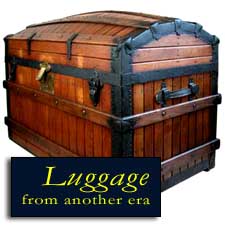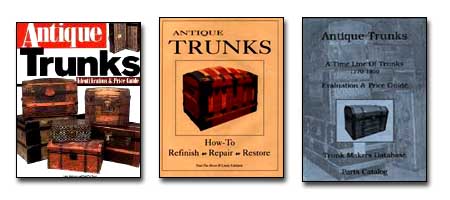
SEACOAST BOOKS
He is a professor of Trunkology. When it comes to antique trunks, nobody knows
more than Paul Pat Morse. Owner of the Trunk Shop in Barrington with his wife
Linda, Pat is the author of three books on old trunks. We've included them here.
As a bonus, Pat answers Frequently Asked Questions about -- you got it -- trunks.
BOOKS ON ANTIQUE TRUNKS
By Paul Pat Morse

What these won’t tell you about that antique trunk you found in the attic, you
don’t need to know. You’ll find color pictures, Victorian trunk images, a database
of trunkmakers, plus info on labels, price evaluation and more. For those who
want to repair their own trunk, there’s a book for you too. Pat Morse has packed
two decades of experience into these books, available from Trunk.com.
- Antique Trunks, Identification and Price Guide
$24.99
- Antique Trunks, Refinish, Repair, Restore
$24.99
- (The Original) Antique Trunks, Identification and Price Guide
$15.99
ANTIQUE TRUNKS FAQ
An exclusive conversation with Paul Pat Morse
We asked Paul Pat Morse, owner of The Trunk Shop, to fill us in on the rising
popularity of antique trunks. How do we know they are popular? Well a recent Antique’s Roadshow newsletter included a three page article on Pat and his popular trunk restoration
business. Pat’s newest book on trunks, his third, sold over 5,000 copies right
out of the gate. His shop, formerly in Portsmouth and now in Barrington is the
center of the universe for those fascinated with vintage travel trunks. -- JDR
Q. What’s all the hoopla about antique trunks?
A. Trunks have come into their own in the last ten years and people are really
excited about them. They are no longer stuck away in attics or rotting in cellars.
People have come to value them as both useful and decorative – and as history.
You can turn a flat top steamer trunk into a distinctive coffee table or use a
dome top trunk to store your winter woolens or quits.
Q. Are there a lot of trunks around?
A. Yes. But they are being bought at a much faster rate these days than, say,
15 or 20 years ago. Over the next several years we will see a marked decline in
the availability of trunks. Especially good or rare trunks.
Q. When did you start with trunks?
A. Don’t get me started. No, really, my brother-in-law, David Edelstein, and
I started with trunks in the mid-1970s when we were visiting a friend, Norman
Smith, in Union, ME. He had a beautifully refinished trunk in his living room
at a time when absolutely no one was looking at trunks as either useful or decorative
or valuable. It was all down (or up) hill from there. Since that time I would
say that, between the two of us, we have refinished or restored several thousand
trunks.
Q. Are trunks valuable?
A. .Some are. Comparing two trunks can be like comparing a Cadillac El Dorado to
a Ford Pinto. Good quality, well-made trunks sell for thousands of dollars. A
flat top Louis Vuitton trunk in good condition might bring $5,000 to $7,000. While
a ca. 1930 flat top steamer trunk with fake leather trim and pressed cardboard
over plywood might be worth $20.
Q. What has been your best buy on a trunk?
A. My wife, Linda, bought a Louis Vuitton trunk at auction one time for $3. I
guess no one else was interested. I once bought a brass bound Jenny Lind trunk
at the giant Brimfield, MA antique flea market for $25.
Q. How can I determine the value of my trunk?
A. You can have it appraised by an antique dealer, or better yet, a dealer who
specializes in trunks. You can most likely find such a dealer on the Internet.
They can very often appraise your trunk by looking at pictures you send them.
Or you can buy a book – like mine -- Antique Trunks: Identification and Price Guide, published by Krause. This book contains a "Valurator System" for effectively
figuring out the value of your trunk.
A. You can have it appraised by an antique dealer, or better yet, a dealer who
specializes in trunks. You can most likely find such a dealer on the Internet.
They can very often appraise your trunk by looking at pictures you send them.
Or you can buy a book – like mine -- , published by Krause. This book contains
a "Valurator System" for effectively figuring out the value of your trunk.
Q. Should I work on my trunk to make it look better?
A. It depends. Most trunks were made after the start of the Industrial Revolution
and there were literally hundreds of thousands of them made. The average steamer
trunk, in good condition, might be worth $300 to $500. Restoring or refinishing
it might raise its value to $800 or even #1,200 -- if the restoration is done
right. But if an amateur restored a high-quality trunk, it might reduce the value.
In fact, you might do damage that could never be undone. Before you work on your
trunk, consult an expert. It probably won’t cost you anything and might very well
save the value of your trunk. You might also consider buying my book, Antique Trunks: Refinish, Repair, Restore. This is an in-depth book that covers every aspect of working on a trunk yourself.
Q. My great grandfather brought my trunk over from Europe. Is that where it was
made?
A. Not necessarily. Many trunkmakers in the United States, such as M.M.Secor,
made tens of thousands of trunks that were shipped to Europe and were, in turn,
brought back to America by Immigrants.
Q. My trunk stinks. How can I get rid of that awful mildew smell?
A. First, remove the interior lining. It may be cloth or paper. It may be easy
or difficult to remove, but it has to all come out. After the lining is gone,
use a spray bottle and slightly dampen the interior and scrape the remaining glue
out with a putty knife. Then wipe the whole thing out with a clean damp cloth.
Next wipe the interior with a 10% bleach 90% water solution. Let it soak in for
a few minutes and then wipe it again with a clean damp cloth. The trunk must now
sit for several days to completely dry out. After it has dried, sand the interior
with 150-grit sandpaper. Seal it with two coats of oil based polyurethane and
you’re done.
Q. What are some of the best and rarest trunks?
A. Jenny Lind trunks are pretty hard to find. Jenny Linds are the trunks that
look like a loaf of bread or an hourglass when viewed from the end. They are named
after the Swedish singer of the same name who came to America in the mid-1850s
and had a trunk like that with her. Good, leather-covered dome-top trunks are
very scarce. Crouch and Fitzgerald made the best of these. Look for a trunk with
leather in good condition. Not all dried out. Also a fitted interior will add
greatly to the value of a trunk. Trunks by a couple of French trunk makers are
highly sought after. Edouard Goyard and Louis Vuitton both made the highest quality
trunks and, in fact, are still in business. Expect to pay a premium for these
trunks but they are worth every penny.
Q. How many trunks should I own?
A. Trunks are like wool socks during a cold New Hampshire winter. You can’t have
too many. I own about 150 trunks and am always looking for more. Granted some
of the trunks I own, I wish I didn’t have. But I can always get rid of them later.
Q. I just refinished a trunk and my niece has asked me for it. Should I give
it to her?
A. You should always give a refinished trunk to any family member who asks for
one. It will keep you busy well into your twilight years.
Paul Pat Morse is a writer from Barrington living in an 18th century cape which he sometimes believes is nothing more than a giant trunk
without handles.
Please visit these SeacoastNH.com ad partners.
























